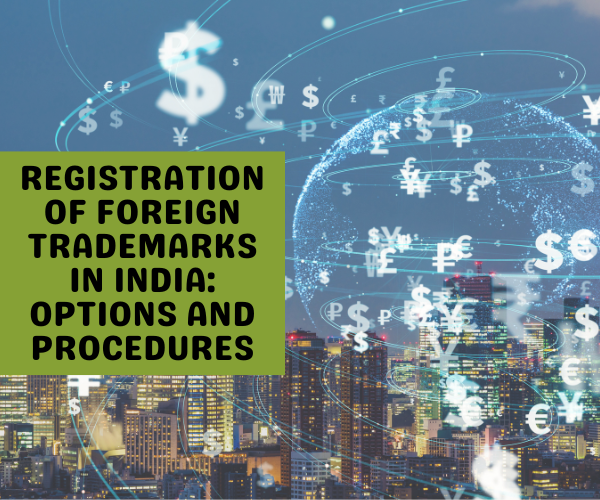Introduction
Logos, brand names and labels are common distinguishers of the goods or services of one undertaking from another. These have been termed as ‘trademarks’ in the legal parlance. Their primary purpose is to establish a distinct identity, reputation and goodwill for the concerned undertaking. Therefore, it is only natural that these trademarks are protected by the legal framework, which comes into play when such trademarks are registered with the relevant governmental authority of the country. For India, this task is undertaken by the Trade Marks Registry.
One very important aspect of such registration is that the protection so granted is territorial in nature, for instance, if a trademark is registered in India, then it will be protected only within the Indian territory. Therefore, in the modern globalised world, companies engaging in transnational operations are compelled to attain registration for their trademarks in all the countries in which they assume business. This leads us to the question of the different ways of registering a trademark in several jurisdictions. With the article being focused on India, it enumerates such ways of registering a trademark in this country.
Registering Foreign Trademarks in India
Registration of trademarks in India is governed by the Trade Marks Act, 1999 and the Trade Mark Rules, 2017. However, this framework is restricted to domestic filings. In order to understand international filings, one has to look at the Madrid System. Thus, two different paths are available to a foreign undertaking looking to register their trademarks in India- firstly, by filing for registration directly with the Indian Trade Marks Registry, and secondly, by filing for registration through the Madrid System.
Filing with the Indian Trademarks Registry
Filing a domestic application in India will involve going through the registration process as established by the domestic laws, and will require engaging trademarks attorneys practicing in India in order to navigate the domestic laws.
The very first step required is to conduct a public search through the government website in order to ensure that an identical or similar trademark is not already registered, followed by the filing of an application along with the requisite fees. The Trade Marks Registry then examines the application and issues an Examination Report. If the trademark is accepted during this stage then the same is advertised in the Trade Marks Journal. The chief objective of such publication is to ensure that the public is aware of the recent applications and can oppose the same if they find that any new trademarks are identical or similar to their already registered ones. Thus, if a trademark is so opposed within the prescribed time limit, then the opposition proceedings are undertaken. Otherwise, the trademark is registered. A detailed account of the domestic procedure for registration of trademarks in India can be found here.
Filing under the Madrid System
The Madrid System was established by the Madrid Agreement and the Madrid Protocol, with the World Intellectual Property Organisation (WIPO) being its primary facilitator. The predominant aim of this system is to facilitate trademark registration in several jurisdictions. Thus, it allows an applicant to apply for registration in several countries at once by filing a single application. The procedure for filing under the Madrid System is enumerated below.
Filing with the Country of Origin
The country of origin refers to the country where the principal place of business of an Applicant is located. For instance, the country of origin for McDonald’s would be the USA. The very first step in a filing under the Madrid System is to attain registration for the concerned trademark in the country of origin, following which the International Application must be submitted as form MM2 along with the documents and fees required as per the domestic laws of the country of origin. The Applicant will have to mention all the countries in which they want to attain registration, which are called the designated contracting parties. In the instant case, India has to be selected as one of the designated contracting parties. An International Application Originating number will be allotted according to the country of origin.
Examination and Registration by WIPO
The office of origin will then forward the application to the International Bureau of the WIPO, which will then scrutinize International Applications received from offices of origin. If any irregularity is found, the International Bureau will notify such irregularities to the office of origin concerned as well as to the applicant/applicant’s authorized representative. The irregularities have to be rectified through the office of origin within the prescribed period.
Thereafter, the trademark will be registered in the International Register and will be in the WIPO Gazette of International Marks along with the issuance of a Certificate of Registration.
The International Bureau will then notify the designated contracting party, India in this instance, of the International Application.
Examination by the Trade Marks Office – India
The Indian Trade Marks Registry will receive the International Application from WIPO and examine the application according to the domestic laws, 2017, and determine the scope of protection to be granted to the trademark. It is to be noted that the Indian Trade Mark Registry is not obligated to grant protection to the concerned trademark in India on the sole grounds that the same has been registered in the International Register.
Analysis and Conclusion
With such basic understanding of both the procedures, it is now prudent to understand which one is beneficial. The duration of protection granted under both is the same, that is, 10 years and can be renewed multiple times without any bar. The term of such renewal is also 10 years. This indicates that there is no difference in the protection granted by either of the methods. Therefore, the cost effectiveness of both has to be analysed. A domestic application is cheaper as compared to an application under the Madrid System, however, it becomes more tedious when seeking registration in several jurisdictions, because filling domestic applications in say 10 countries, would require preparation of 10 different applications. On the other hand, under the Madrid System, registration can be attained in several jurisdictions without having to file multiple applications. An Applicant only has to mention all the countries in which they seek registration. Thus, the procedure to be adopted has to be decided on a case-to-case basis.




